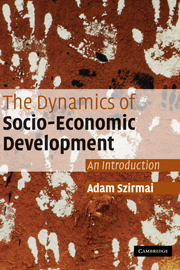Book contents
- Frontmatter
- Contents
- List of figures
- List of tables
- List of boxes
- Preface
- List of abbreviations
- Acknowledgements
- Chapter 1 Developing countries and the concept of development
- Chapter 2 Development of the international economic order, 1450–2000
- Chapter 3 Growth and stagnation: theories and experiences
- Chapter 4 Technology and development
- Chapter 5 Population and development
- Chapter 6 Health, health care and development
- Chapter 7 Education and development
- Chapter 8 Economic development, structural transformation and primary exports
- Chapter 9 Industrial development
- Chapter 10 Agricultural development and rural development
- Chapter 11 State formation and political aspects of development
- Chapter 12 Cultural dimensions of development
- Chapter 13 The international economic and political order since 1945
- Chapter 14 Foreign aid and development
- Bibliography
- Author index
- Subject index
Chapter 8 - Economic development, structural transformation and primary exports
Published online by Cambridge University Press: 05 June 2012
- Frontmatter
- Contents
- List of figures
- List of tables
- List of boxes
- Preface
- List of abbreviations
- Acknowledgements
- Chapter 1 Developing countries and the concept of development
- Chapter 2 Development of the international economic order, 1450–2000
- Chapter 3 Growth and stagnation: theories and experiences
- Chapter 4 Technology and development
- Chapter 5 Population and development
- Chapter 6 Health, health care and development
- Chapter 7 Education and development
- Chapter 8 Economic development, structural transformation and primary exports
- Chapter 9 Industrial development
- Chapter 10 Agricultural development and rural development
- Chapter 11 State formation and political aspects of development
- Chapter 12 Cultural dimensions of development
- Chapter 13 The international economic and political order since 1945
- Chapter 14 Foreign aid and development
- Bibliography
- Author index
- Subject index
Summary
As long as people work with their bare hands, their daily production will remain low. This sets a limit to the attainable level of economic welfare in a traditional agriculture-based economy. Higher standards of living can only be realised if production per worker increases. One of the principal ways to raise labour productivity is by providing workers with tools, implements and machines – in other words through capital accumulation.
Capital accumulation is intimately associated with the emergence of an industrial sector. Therefore, economic development is linked to structural change and industrialisation. This chapter focuses on structural change and the relationships between agriculture and industry in the course of economic development. It provides a setting for the discussion of industrialisation in Chapter 9 and agricultural development in Chapter 10.
The point of departure is the fact that in the process of economic development the share of the agricultural sector in production and employment declines and the share of the industrial sector increases. However, this does not mean that the agricultural sector should be neglected. This chapter argues for a positive view of the contributions of the agricultural sector to the wider process of development. The argument consists of two main elements. First, successful industrialisation processes are usually preceded by increases in agricultural productivity. Second, in later stages of development a stagnating agricultural sector can be an obstacle to further development of the entire economy. Therefore, a balanced approach to agriculture and industry is called for.
- Type
- Chapter
- Information
- The Dynamics of Socio-Economic DevelopmentAn Introduction, pp. 255 - 302Publisher: Cambridge University PressPrint publication year: 2005



